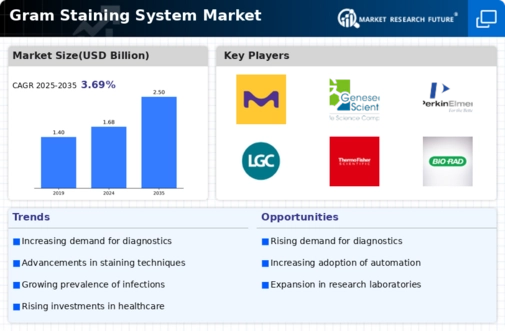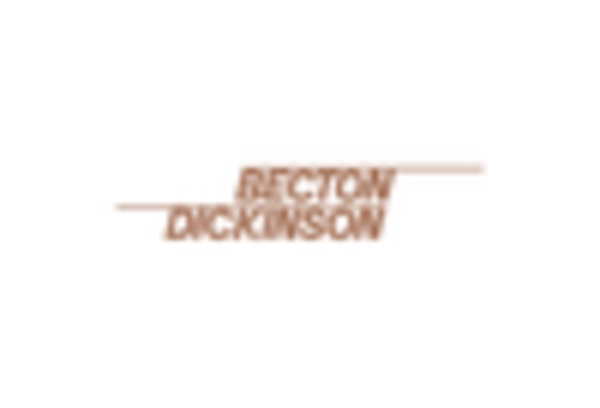Collaboration and Research Initiatives
The Gram Staining System Market is benefiting from collaborative efforts and research initiatives among academic institutions, healthcare organizations, and industry players. These partnerships are fostering innovation in Gram staining methodologies and technologies. Research projects aimed at improving the sensitivity and specificity of Gram staining are underway, which could lead to the development of next-generation staining systems. Furthermore, funding from governmental and non-governmental organizations for research in microbiology is likely to stimulate advancements in this field. As a result, the market may see an influx of novel products that enhance diagnostic capabilities. Such collaborations not only drive technological progress but also create a more robust ecosystem for the Gram staining market, potentially increasing its competitiveness and appeal.
Rising Demand for Point-of-Care Testing
The Gram Staining System Market is witnessing a surge in demand for point-of-care testing solutions. As healthcare systems strive to provide immediate diagnostic results, Gram staining has emerged as a vital tool in point-of-care settings. The ability to quickly identify bacterial pathogens directly at the site of care can significantly improve patient management and treatment outcomes. Recent studies indicate that the point-of-care testing market is expected to grow at a rate of 8% annually, with Gram staining systems playing a crucial role in this expansion. This trend is particularly evident in emergency departments and outpatient clinics, where rapid diagnosis is essential. Consequently, manufacturers are likely to focus on developing portable and easy-to-use Gram staining devices to meet this growing demand, thereby enhancing the market's potential.
Growing Awareness of Antimicrobial Resistance
The Gram Staining System Market is increasingly shaped by the growing awareness of antimicrobial resistance (AMR). As healthcare professionals recognize the critical need for accurate bacterial identification to combat AMR, the demand for Gram staining systems is likely to rise. Gram staining serves as a fundamental technique in determining the appropriate antibiotic treatment, which is essential in managing resistant infections. Recent reports suggest that the global burden of AMR is escalating, prompting healthcare systems to prioritize effective diagnostic methods. This awareness is driving investments in Gram staining technologies that can provide rapid and reliable results. As a result, the market may experience significant growth as healthcare providers seek to enhance their diagnostic capabilities in the face of rising AMR challenges.
Increased Focus on Infectious Disease Diagnosis
The Gram Staining System Market is significantly influenced by the heightened emphasis on infectious disease diagnosis. With the rising incidence of bacterial infections, healthcare providers are increasingly relying on Gram staining as a primary diagnostic tool. This method allows for the rapid differentiation of bacteria, which is essential for timely treatment decisions. According to recent data, the prevalence of bacterial infections has surged, leading to a greater demand for effective diagnostic solutions. Consequently, the market is expected to grow as healthcare institutions invest in advanced Gram staining systems to improve patient outcomes. Additionally, public health initiatives aimed at controlling infectious diseases are likely to further propel the adoption of Gram staining techniques, thereby enhancing the overall market landscape.
Technological Advancements in Gram Staining Systems
The Gram Staining System Market is experiencing a notable transformation due to rapid technological advancements. Innovations in staining techniques and automated systems are enhancing the accuracy and efficiency of bacterial identification. For instance, the integration of digital imaging and artificial intelligence in Gram staining processes is streamlining workflows in laboratories. This shift not only reduces human error but also accelerates the diagnostic process, which is crucial in clinical settings. As a result, the market is projected to witness a compound annual growth rate of approximately 6% over the next few years, driven by the demand for more precise and faster diagnostic tools. Furthermore, the introduction of user-friendly interfaces in Gram staining equipment is likely to attract a broader range of healthcare facilities, thereby expanding the market reach.

















Leave a Comment